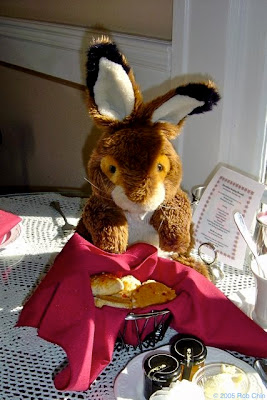You know what Rob named that photo? “Statutory.” Couldn’t stop him if I tried.
In any case, that was a wonderful visit—we made it around the entire 120-acre garden in one go and even had time left over to crash the famous Rose Garden Tea Room. After all, what could possibly be more English than a little brown rabbit coming to tea? Yum, fresh scones with marmalade and Devonshire cream!
But now that it’s been five-plus years since that trip to San Marino, we figured we were due to return—overdue, really, considering they opened the Chinese garden back in 2008. Around here, Japanese gardens are pretty common (we couldn’t go anywhere last summer without running across one), but authentic Chinese gardens are harder to come by. And judging by this model in the main entranceway, it should be pretty impressive!
So from the Huntington entrance, we head north past the far side of the conservatory, and there we find Liu Fang Yuan—the Garden of Flowing Fragrance—cordoned off by the rippling Jing Yun Bi, the Wall of the Colorful Clouds. Looks promising, doesn’t it?
And here’s what lies within! Sure enough, the garden is suffused with the scent of jasmine, but it’s the views that really take your breath away. Across the Lake of Reflected Fragrance, we see the Pavilion of the Three Friends, the Jade Ribbon Bridge, and, in the background, the Love for the Lotus Pavilion. And in the foreground, the Rabbit of a Thousand Daytrips.
Why all the flowery names? It’s because poetry has a very literal presence in Chinese gardens, both in the names of things and in actual inscriptions etched in various places throughout, such as here on the Bridge of Strolling in the Moonlight.
I mean, you didn’t think I go around doing linguistically appropriate tagging or something, did you?
As another example, the brochure says the couplet on the Love for the Lotus Pavilion translates as:
Though rooted in the mud, how could the lotus be sullied?...which I’m assuming is the text you can sort of make out in this shot, along with the little girl I’m waving back at from the Bridge of Verdant Mist.
Its fragrance spreads far with even greater purity.
Oh yes, the multiple bridges. Chinese gardens are highly architectural, traditionally enclosed by at least one wall (as you’ve seen) and then partitioned into multiple vistas by a variety of structures. The Lake of Reflected Fragrance is spanned by no fewer than five bridges, each completely different in size and design. Well, why not, right?
Even the natural elements are used differently than they are in Japanese gardens. Chinese gardens tend to have larger, more centralized water features and plants that are selected first and foremost for their symbolic meanings—pine for longevity, peonies for wealth, lotuses for purity, and so forth. The Pavilion of Three Friends is so named for its placement near a grove of pine, bamboo, and plum blossoms, all of which thrive during the winter and early spring and therefore are seen as symbols of resilience and strength of will.
Okay, yeah, I’m just taking the brochure’s word for some of this.
But perhaps the most distinctive and readily identifiable characteristic of Chinese gardens are the “scholar’s rocks,” those quirky pieces of pockmarked stone that recall the jagged mountains of China and are mounted on pedestals like nature’s own abstract art. Carvings or markings on scholar’s rocks are generally frowned upon, so what you see is, in all likelihood, the way they were found.
I suppose if I had to be upstaged by a chunk of limestone, this is a pretty good one.
Now, something that Chinese and Japanese gardening do have in common is the cultivation of miniature trees, except where the latter’s art of bonsai likes a more manicured look, the former’s penjing favors it on the naturalistic side—bushier boughs, roots that grow over rocks, that sort of thing. But either way, I get to feel like a giant for a change, so hey.
A full circuit around the lake eventually brings us to the rounded portals of the Terrace of the Jade Mirror, the “jade mirror” being a reference to the full moon, which was sometimes compared to a mirror of white nephrite. Four different views, depending on which way you face, or—as in this case—you can have two parties using it as a cool photographic backdrop in two different directions simultaneously!
And having circled around to our starting point, I think it’s time for a snack at the teahouse. Last time it was a proper English tea on an autumn afternoon, this time it’s lakeside dim sum on a beautiful spring day. It’s hard to lose here, isn’t it?
Unfortunately, we weren’t able to go through the Japanese garden for comparison during this visit—it’s currently undergoing renovations, and this was as close as we could get to it today. If it’s not one thing, it’s another...
...but then again, I suppose we could just return in another five years! Well, in the meantime, remember it this way, and we’ll see what 2016 brings!












